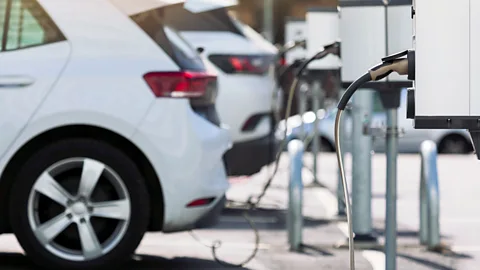Electric vehicles: Can 'lightweighting' combat range anxiety?
 Getty Images
Getty ImagesOne of the biggest barriers to electric vehicles is the distance they can travel on a single charge, so some manufacturers are shedding weight from their cars to squeeze more miles from their batteries.
It seems like a simple enough choice. The widespread use of electric vehicles could trigger a potential "positive tipping point" in the efforts to limit global warming. But many motorists are still choosing not to make the switch to this low-carbon technology. It is a decision that has meant while electric vehicle uptake has been rapid, it's been slower than some car manufacturers anticipated.
There are many reasons why consumers are not moving to electric vehicles as quickly as expected, including price, charging infrastructure and concerns about how far they can travel – so-called "range anxiety". Drivers want to be able to charge and go in the same time it takes to fill a tank with petrol or diesel, and they want the same mileage per charge of the battery, according to Achyut Jajoo, senior vice president and general manager of manufacturing and automotive at customer relations management software firm Salesforce, which recently surveyed 2,000 drivers on consumer preferences.
But with today's lithium-ion batteries, EVs can only go so far.
Now at the Consumer Electronics Show (CES) in Las Vegas, Nevada, US, this week, there are signs that some auto companies are looking for innovative ways to overcome these obstacles to adoption, particularly in the North American market. Their solution? Make cars lighter.
"Every ounce of that weight reduction improves range," says Andrew Poliak, US chief technology officer of Panasonic Automotive. The company says it has developed components – such as the speakers and audio system used in cars – that not only weigh between 30-60% less but also draw 60% less power from the car without affecting performance.
"With electric vehicles using our lightweighting technology, like wiring and harness (which hold the wires in place) reduction technologies, and our technological advancements in the amplifiers and in algorithms that are used to make audio system sound good, we put all those to bear to bring a really nice sound system while actually reducing the amount of power drain," he says.
At CES in 2023, Panasonic showed off two-inch (5cm) speakers that fit into a car's dashboard and were able to produce sound typically made by larger six-inch (15cm) speakers in the door, says Poliak. The technology removed significant weight in the doors. Now, he says, Panasonic is doubling down on that concept to further lightweight the interior of vehicles.
This year at CES, Panasonic's "lightweighting" concept is featured inside the Fisker Ocean One All-Electric SUV and the Infiniti QX80. The company is also displaying a see-through concept vehicle they're calling their device car, in an effort to showcase all of the different components that the company is optimising for car makers.
You might also like:
Another major car manufacturer, Honda, is looking at a different key component in electric cars in the effort to shed weight – the battery itself. It has been making substantial investments in developing solid-state batteries, which are smaller and lighter than the conventional lithium-ion batteries currently standard in most electric vehicles on the road today. The battery technology also has the ability to charge faster and is less susceptible to heat-related damage from fast-charging.
This brings added benefits, says Honda spokesperson Chris Martin. Not having to worry about the battery overheating means it may not need the same safety features around it, offering another way to lightweight the car.
"When you add weight to the vehicle, it means you need a bigger battery to attain the same range," says Martin. "It has a cascading effect because of the vulnerability of lithium-ion batteries. If you can remove that vulnerability, you can reduce vehicle weight and put batteries in new locations. If you wanted to keep the vehicle the same way, you could theoretically take out some of the crash structure that was just protecting the battery – not the people – and put in more battery."
 Getty Images
Getty ImagesEVs certainly saw a mixed year in 2023. While demand from private users in the UK fell, company fleet orders were up. And while global predictions had suggested a continued exponential rise in uptake, some manufacturers warned that the rapid growth is set to slow. But lighter-weight components could also help to bring the cost of these vehicles down, too.
"I think it's inevitable that as the technology advances, the capital costs for an electric vehicle will go down," says Poliak.
The question that remains, however, is whether consumers will think much lighter electric cars really can go the distance.
--
Sign up for Tech Decoded
For more technology news and insights, sign up to our Tech Decoded newsletter. The twice-weekly email decodes the biggest developments in global technology, with analysis from BBC correspondents around the world. Sign up for free here.
--
If you liked this story, sign up for The Essential List newsletter – a handpicked selection of features, videos and can't-miss news delivered to your inbox every Friday.
